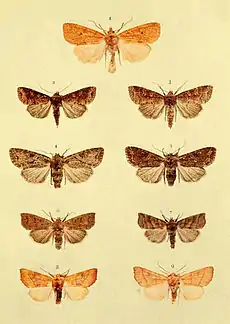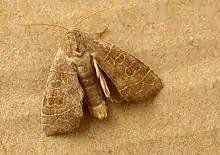Ipimorpha subtusa
Ipimorpha subtusa, the olive, is a moth of the family Noctuidae. It is found in the Palearctic realm (Europe, Russia, Turkey, Siberia, Russian Far East, Mongolia, China, Korea, and Japan).

| Ipimorpha subtusa | |
|---|---|
 | |
| Scientific classification | |
| Kingdom: | |
| Phylum: | |
| Class: | |
| Order: | |
| Family: | |
| Tribe: | |
| Genus: | |
| Species: | I. subtusa |
| Binomial name | |
| Ipimorpha subtusa (Denis & Schiffermüller, 1775) | |
Technical description and variation
The wingspan is 27–30 mm. The length of the forewings is 14–16 mm. Forewing with outcurved termen. Forewing olive grey-brown; inner and outer lines outwards directed, the inner straight, the outer slightly curved, pale yellow; the costal edge also yellow; the median shade obscure; the submarginal line faint, with a dark shade before it; the stigmata with pale margins; hindwing dark grey, with the fringe pale; the ab. pallida Tutt is a colourless pale grey form without any rufous or fuscous admixture.[1]
Biology
The moth flies in one generation from mid-June to mid-September . Larva pale yellowish green; dorsal line broadly, subdorsal narrowly yellowish; spiracular line pale yellow; head yellow marked with black. The larvae feed between the united leaves of aspen and other poplar species.[2]
Notes
- ^ The flight season refers to Belgium and The Netherlands. This may vary in other parts of the range.
References
- Seitz, A. Ed., 1914 Die Großschmetterlinge der Erde, Verlag Alfred Kernen, Stuttgart Band 3: Abt. 1, Die Großschmetterlinge des palaearktischen Faunengebietes, Die palaearktischen eulenartigen Nachtfalter, 1914
- "Robinson, G. S., P. R. Ackery, I. J. Kitching, G. W. Beccaloni & L. M. Hernández, 2010. Hosts - A Database of the World's Lepidopteran Hostplants. Natural History Museum, London".